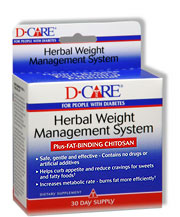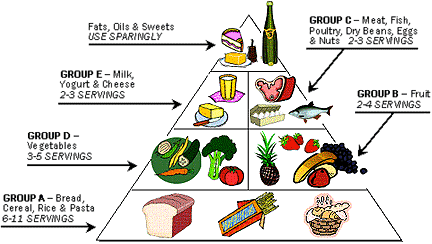|
 Weight Management Weight Management
System Program
A Complete
Plan Including Exercise and Meal Planning
Introduction
The D-Care®
Weight Management System has been formulated in response to the
people who want a safe and effective way to gently and quietly reduce
their appetite and reduce cravings for fatty foods and sweets.
For people
who want to lose weight or maintain their ideal weight, this system
provides the opportunity to accomplish their goals without the nervous
or jittery energy response caused by other weight reduction products.
The D-Care
Herbal Weight Management System allows you to eat sensibly, control
your appetite, and reduce your need for fatty or sweet foods naturally
without drugs or artificial additives.
As with all
diet or weight management programs or plans, you should consult
your physician to insure that you maintain a proper balance of foods
and exercise, as well as to prevent any interaction with any medication
or treatment you may presently be on.
The D-Care
Weight Management System allows you to eat the foods you love, and
then as your eating habits slowly change, gradually begin to primarily
eat the foods from the bottom of the food pyramid (foods that are
good for you and your weight control). Remember what you eat and
how you eat is an important part of this system, as is regular exercise.
How To Begin
The program
includes three important components: (1) Supplementation with the
Weight Management System, (2) Exercise, and (3) Meal Planning using
the Food Selection Table.
1. Supplementation
with the Weight Management System
Your daily
routine will include taking the appropriate dosage of the Herbal
Complex and Active Booster formulas of the Weight Management System
(consult box and bottle labels for details), preferably with food
or after a meal. In the Sample Menu
presented below, we suggest taking half of the daily dose with a
morning snack, and the other half with an afternoon snack.
2. Exercise
Exercise is
important to your overall health and is the easiest thing you can
do to greatly enhance your results under this program. Effective
exercise routines can include one or more of the following exercise
examples (ideally at least one from each category):
- Cardio-Respiratory
Walk, bicycle, play tennis, stair climbing, low-impact aerobics,
dancing.
- Flexibility
Stretching, yoga.
- Strength
Resistance machines, dumbbells, barbells, dynabands.
Important:
Before starting any exercise program, be sure to consult with your
physician.
3. Meal
Planning
Eating Your
Way To A Healthier You
For best results, we recommend that you begin to eat from the food
groups shown at the bottom of the USDA Pyramid (diagram adapted
from the U.S. Department of Agriculture food group pyramid released
in 1992). To help you select enjoyable, daily menus that focus on
these healthy food groups, we've put together a Sample
Menu below. Use the Food Selection
Tables to assist you in making your menu choices. And remember
to keep variety in your meals and occasionally include the foods
you really enjoy.

Sample Menu
| Food
Selection List |
Example |
| Breakfast |
| 1
Serving from Group A or B |
1
Bagel |
| 1
Serving from Group C or D |
1
oz. Cream Cheese |
Snack
(10 a.m.)
Take one-half of the daily dosage of the Weight Management System |
| 1
Serving from Group B |
1
Apple |
| Lunch |
| 1
Serving from Group C or E |
4
oz. of Turkey |
| 1
Serving from Group A or D |
Garden
Salad |
Snack
(4 p.m.)
Take the other half of the daily dosage of the Weight Management
System |
| 1
Serving from Group B |
1
Banana |
| Dinner |
| 1
Serving from Group A |
1
Baked Potato |
| 1
Serving from Group C or E |
4
oz. of Fish |
| 1
Serving from Group D |
2
cups of Cooked Broccoli |
Notes:
Water Intake: Try to drink at least 8 glasses of water per day to
flush those excess pounds and inches away and to keep your body
at peak performance.
Alcohol Intake: Limit your alcohol consumption, and eliminate if
possible.
Food Selection
Table
These lists
have been prepared in accordance with the USDA Pyramid and include
foods recognized by leading health authorities as contributing to
maximum health. Choose items that you especially like to eat and
then build your daily menus to help reach your long-term weight
goals.
GROUP A
- Bread, Cereal, Rice & Pasta
Breakfast
Breads
Bagel - 1 whole
Biscuit - 1 medium
Cracked Wheat - 2 slices
English Muffin - 2 slices
French - 2 slices
Italian - 2 slices
Pita - 1 slice
Pumpernickel - 1slice
Raisin - 2 slices
Rye - 2 slices
Sourdough - 2 slices
White (enriched) - 2 slices
Whole Wheat - 2 slices
Cereals
All Bran - 1 cup
40% Bran Flakes - 1/2 cup
100% Bran - 1/2 cup
Cheerios - 1 cup
Corn Flakes - 1 cup
Cream of Wheat (reg.) - 3/4 cup
Cream of Rice (reg.) - 3/4 cup
Farina, Cooked - 1 cup
Grape Nut Flakes - 2/3 cup
Kix - 1 cup
Malt-O-Meal - 3/4 cup
Oak Flakes, Post - 2/3 cup
Oatmeal (instant) - 1 pack
Oatmeal (regular) - 3/4 cup
Product 19 - 3/4 cup
Puffed Oats/Rice/Wheat - 1/3 cup
Raisin Bran - 1 cup
Rice Chex - 1 cup
Shredded Wheat - 1 biscuit
Shredded Wheat (spoon size) - 1/2 cup
Special K - 1 cup
Total - 1 cup
Wheaties - 1 cup
Whole Bran - 1/2 cup
Muffin - 1 medium
Pancakes (4" diameter) - 2
Lunch/Dinner
Breads/Complex
Carbohydrates
Bagel - 1 whole
Biscuit - 1 medium
Brown Rice - 1 cup
Bun (hamburger/hot dog) - 1 medium
Corn Bread - 1 slice
Dinner Roll - 1 medium
English Muffin - 2
French/Italian - 2 slices
Raisin Bread - 2 slices
Rye Bread - 2 slices
White Bread - 2 slices
Whole Wheat Roll - 1 medium
Whole Wheat Bread - 2 slices
Muffin - 1 medium
Cooked Pasta
& Rice
Egg Noodles - 1 cup
Flour Pasta - 1 cup
Wheat Pasta - 1 cup
Potato, Baked - 1 medium
Rice Cakes - 3
Rice, White/Brown - 1 cup
Spaghetti - 3/4 cup
Sweet Potato - 1 medium
GROUP B
- Fruit
Apple - 1 medium
Apple Juice - 1 cup
Applesause (unsweetened) - 1 cup
Apricot - 3 small
Banana - 1 medium
Blackberries - 1/2 cup
Boysenberries - 1 cup
Cantaloupe - 1/2 regular
Cherries - 1 cup
Cranberries - 1 cup
Grapes - 1 cup
Honeydew Melon - 1/3
Kiwi - 2 small
Mango - 1/2 regular
Nectarine - 1 whole
Orange - 1 whole
Orange Juice - 1 cup
Papaya - 1/2
Passion Fruit - 2 whole
Peach - 2 whole
Pear - 2 whole
Pineapple - 1 cup
Plum - 2 whole
Raspberries - 1 cup
Strawberries - 2 cups
Tangerine - 2 whole
Watermelon - 2 cups
GROUP C
- Meat, Poultry, Fish, Beans & Eggs
Meat
Beef (ground) Lean - 2 oz.
Beef (ground) Round - 2 oz.
Flank Steak - 2 oz.
Lean Cut Steak - 2 oz.
Round Steak - 2 oz.
Poultry
Breast (light), Skinless - 3 oz.
Breast (dark), Skinless - 3 oz.
Sliced Turkey Breast - 4 oz.
Turkey Chunk White/Water - 4 oz.
Turkey Ground 93% Fat Free - 3 oz.
Fish
Bass - 4 oz.
Bluefish - 4 oz.
Catfish - 4 oz.
Clams - 5 large
Clams, Canned - 6 oz.
Cod - 4 oz.
Crab - 4 oz.
Crabmeat, Imitation - 4 oz.
Flounder - 4 oz.
Grouper - 4 oz.
Haddock - 4 oz.
Halibut - 4 oz.
Lobster - 4 oz.
Ocean Perch - 3 1/2 oz.
Oysters - 5 large
Oyster, Canned - 6 oz.
Red Snapper - 4 oz.
Salmon - 3 oz.
Shark - 3 1/2 oz.
Shrimp - 8 large
Sole - 4 oz.
Swordfish Steak - 3 1/2 oz.
Trout - 3 1/2 oz.
Tuna, Canned in Water - 4 oz.
Whitefish - 3 oz.
Beans
Kidney Beans, Cooked - 1/2 cup
Black Beans, Cooked - 1/2 cup
Eggs
Eggs - 1 whole
Egg Whites - 5
GROUP D
- Vegetables
Alfalfa Sprouts
- 1 cup
Asparagus - 4 spears
Beets - 1 cup
Broccoli - 2 cups
Brussel Sprouts - 2 cups
Cabbage - 2 cups
Carrots - 2 cups
Cauliflower - 2 cups
Celery - 1 cup
Corn - 1/2 cup
Garden Salad - 1 medium
Green Beans - 2 cups
Lentils, Cooked - 1/2 cup
Lettuce, Iceberg - unlimited
Lettuce, Romaine - unlimited
Lima Beans - 1/2 cup
Mushrooms - 1 cup
Okra - 2 cups
Onion - 1 whole
Peas - 1/2 cup
Potatoes, Baked - 1 medium
Spinach - 2 cups
Sweet Potato - 1 medium
Tomato - 1 medium
Totato, Canned - 1 cup
Tomato Juice - 1 cup
Vegetable Juice (V-8) - 1 cup
Yellow Wax Beans - 2 cups
GROUP E
- Milk, Yogurt & Cheese
Cheese
Cheddar - 1 oz.
Milk
Whole - 3/4 cup
Low-Fat - 1 cup
Non-Fat - 1 1/2 cups
Yogurt
Low-Fat with Fruit - 8 oz.
Non-Fat with Fruit - 8 oz.
Low-Fat, Plain - 8 oz.
Non-Fat, Plain - 8 oz.
Frozen, Low-Fat - 4 oz.
Frozen, Non-Fat - 6 oz.
|

![]()
![]()
 Weight Management
Weight Management